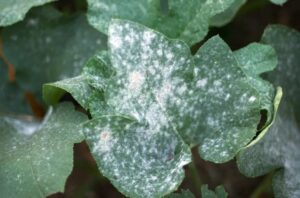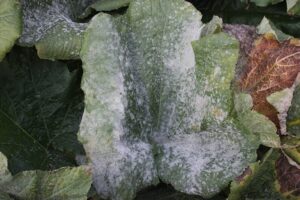Characteristics of powdery mildew
Powdery mildew is a common fungal disease that infects a broad spectrum of plants, including trees and shrubs, perennials, grasses, fruits and vegetables. It is not a single disease but is caused by a group of related fungi in the Erysiphaceae family. Regardless of the fungal source, the appearance of the disease is the same, i.e., a grey-white, dusty-looking coating on the surface of leaves or other plant parts. While it may look unsightly, in ornamental plants the effect is primarily cosmetic, although in severe cases it may reduce plant growth and flowering.
Powdery mildews are host specific, in that they need the proper host plant to survive, but a fungus may attack a range of closely related plants and not be limited to a single host. For example, the powdery mildew that infects lilac will not infect cosmos but the powdery mildew that infects oaks can also infect rhododendrons and dogwoods.

powdery mildew on leaf
Source: Jeff Kubina / Flickr / CC BY-SA 2.0
How the disease spreads and survives
The disease is spread by spores which are easily carried by the wind and may spread over a large area. When a spore lands on a receptive host plant, it will quickly germinate and start a new infection. Unlike many fungal diseases, the spores do not need moisture on the leaf to start the process. Specialized structures penetrate the plant tissue to take up nutrients, while strands of the fungus grow over the surface of the plant part and produce more spores, resulting in the dusty coating symptomatic of the disease.
All fungi that cause powdery mildew are obligate parasites: they need a living host to grow and reproduce, but they are able to overwinter in various ways. Some fungi are able to penetrate the buds of their host plant and overwinter there. Others survive in small, black structures called cleistothecia. The cleistothecia, usually found in plant debris and fallen leaves, protect the spores during the winter and allow them to survive in the absence of a host. When the weather warms up in the spring, the spores are released to begin the process of re-infection.
Powdery mildew is most obvious in late summer or early fall as the fungi thrive with humid nights that stimulate the production of spores followed by warm, sunny days that encourage the spores to spread.
Cultural control
- Ensure adequate spacing of plants to increase air circulation or prune out overcrowded plants.
- Trees with dense foliage, such as Norway maple, may benefit from having the crown thinned out to increase air circulation.
- Pick off diseased leaves of perennials as they occur in summer or cut the foliage back in late summer and remove from the garden.
- Look for disease resistant cultivars of plants, such as roses, phlox, bee balm and crabapples, that are prone to powdery mildew.
- Cut back on nitrogen fertilizer if you are using it, as too much nitrogen causes succulent growth that encourages the disease.
- Water in the morning and use a soaker hose to avoid wetting the foliage.
- To interrupt the life cycle of the fungus, rake and remove all diseased plant parts and send the debris to the city for composting. Home composting may slow down the rate of reinfection but is generally not hot enough to kill all the fungal spores.

Source: https://gardening.usask.ca/articles-and-lists/articles-diseases/disease-powdery-mildew.php
Resources
Ask an arborist: Powdery mildew. Yourleaf.org blog, September, 2013.
NYBG Plant and Gardening FAQ. NYBG Mertz Library Reference, September, 2023.
University of Minnesota Extension. Powdery mildew on trees and shrubs. 2018
Douglas, Dr. Sharon. Connecticut Agricultural Experiment Station. Powdery mildew. 2011.
Colorado State University Extension. Powdery Mildews. 2013.

